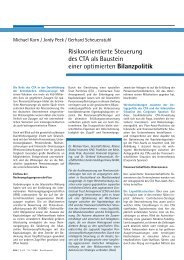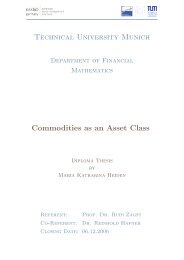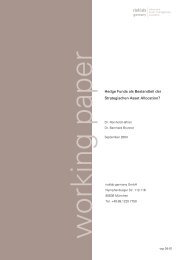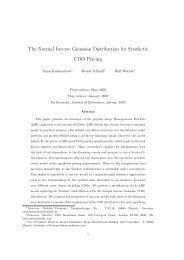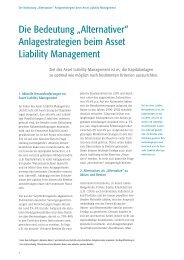Technische Universität München Credit as an Asset Class - risklab
Technische Universität München Credit as an Asset Class - risklab
Technische Universität München Credit as an Asset Class - risklab
You also want an ePaper? Increase the reach of your titles
YUMPU automatically turns print PDFs into web optimized ePapers that Google loves.
CHAPTER 2. CREDIT RISK TRANSFER<br />
• Recovery rates – the fraction of the nominal amount which may be recovered in c<strong>as</strong>e<br />
of counterparty default.<br />
• <strong>Credit</strong> migration – the expected ch<strong>an</strong>ges in credit quality of the obligor or counter-<br />
party.<br />
Furthermore, there are portfolio risk elements:<br />
• Default <strong>an</strong>d credit quality correlation – the degree of correlation between default or<br />
credit quality of one obligor <strong>an</strong>d <strong>an</strong>other.<br />
• Risk contribution <strong>an</strong>d credit concentration – the contribution of one instrument in<br />
the portfolio to the overall portfolio risk. 2<br />
2.1.2 <strong>Credit</strong> Risk <strong>an</strong>d Regulation<br />
Bearing credit risk is <strong>an</strong> essential part of b<strong>an</strong>king <strong>an</strong>d a signific<strong>an</strong>t source of income<br />
for fin<strong>an</strong>cial institutions. Consequently, it is import<strong>an</strong>t to monitor <strong>an</strong>d m<strong>an</strong>age the risk<br />
positions in the portfolio continuously. In order to have a diversified credit portfolio, it<br />
is crucial to avoid concentration of credit risk vis-à-vis a client or <strong>an</strong> industry. This is<br />
vital for each single fin<strong>an</strong>cial institution in order to reduce its risk of fin<strong>an</strong>cial distress <strong>an</strong>d<br />
thus ensuring the stability of the fin<strong>an</strong>cial system, which is finally the main re<strong>as</strong>on for<br />
regulation.<br />
1988 B<strong>as</strong>el Accord<br />
According to the 1988 B<strong>as</strong>el Accord, b<strong>an</strong>ks have to hold capital in reserve – the so-<br />
called regulatory capital – in order to be able to offset losses resulting from credit or<br />
market risk. It uses only four different risk weights to distinguish between <strong>as</strong>set categories.<br />
Thus, the risk structure of the <strong>as</strong>sets in a b<strong>an</strong>k’s bal<strong>an</strong>ce sheet determines the minimum<br />
regulatory capital. Vice versa, a given regulatory capital limits risk-bearing credit <strong>an</strong>d<br />
trading tr<strong>an</strong>sactions of a b<strong>an</strong>k. Therefore, b<strong>an</strong>ks have <strong>an</strong> incentive to look for capital<br />
relief, for example by using credit derivatives.<br />
At its inception, this first approach to a risk-b<strong>as</strong>ed supervisory process represented <strong>an</strong><br />
innovative <strong>an</strong>d intelligent way of regulation. In the me<strong>an</strong>time, however, a rapid technolog-<br />
ical <strong>an</strong>d fin<strong>an</strong>cial evolution h<strong>as</strong> taken place, undermining the effectiveness of regulation.<br />
This development dem<strong>an</strong>ded a new, modern framework taking into account the incre<strong>as</strong>ing<br />
number of complex fin<strong>an</strong>cial products, other forms of risk such <strong>as</strong> operational risk, <strong>an</strong>d<br />
risk weights better aligned with actual risk inherent in a b<strong>an</strong>k’s <strong>as</strong>sets.<br />
B<strong>as</strong>el II Accord<br />
In 2004, a new Capital Accord for international operating b<strong>an</strong>ks, the B<strong>as</strong>el II Accord, w<strong>as</strong><br />
p<strong>as</strong>sed. It constitutes a framework b<strong>as</strong>ed on three pillars: Minimum capital requirements,<br />
supervisory review process <strong>an</strong>d enh<strong>an</strong>ced disclosure. The Accord h<strong>as</strong> to be implemented<br />
by the signatory countries by the end of 2006. It c<strong>an</strong> be considered <strong>as</strong> a milestone for the<br />
international harmonisation of regulation. It h<strong>as</strong> to overcome weaknesses of B<strong>as</strong>el I such <strong>as</strong><br />
2 See [BK04], p. 376 <strong>an</strong>d [Sch03], pp. 2-3.<br />
5




